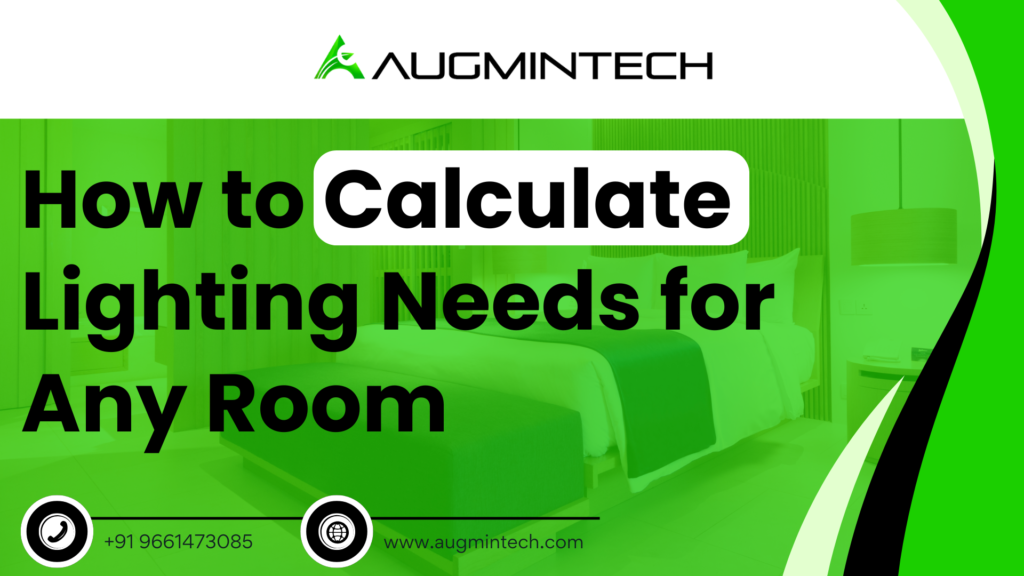How to Calculate Lighting Needs for Any Room
- January 7, 2025
- 4:31 pm
- 2800+ Comments
Calculating Lighting Requirements
Proper lighting can transform any room, enhancing its functionality, ambiance, and overall comfort. But how do you ensure that your space is neither too dim nor overly bright? This blog dives into the science of lighting, focusing on how to calculate lumens and wattage based on room dimensions and purpose. By the end, you’ll be equipped with practical tips and formulas to achieve perfect lighting for your home or workspace.

Why Lighting Matters in Interior Design
Lighting isn’t just about aesthetics; it’s fundamental to how a room feels and functions. The right lighting:
- Improves visibility for tasks and activities.
- Enhances mood and ambiance.
- Highlights architectural and design features.
Whether you’re setting up a cozy living room, a functional kitchen, or a productive office space, the first step is determining your lighting needs.
Table of Contents
Key Questions When Calculating Lighting Needs
What is the room’s purpose?
A kitchen or workspace requires bright, focused lighting, while a bedroom benefits from softer, ambient light.What are the room’s dimensions?
Larger spaces need more light, while smaller rooms require less.What kind of lighting do you want?
Ambient (general lighting), task lighting, or accent lighting all have different requirements.
How to Calculate Lighting Needs: A Step-by-Step Guide
1. Measure Your Room Dimensions
Start by measuring the width and length of the room in feet. For example, a room measuring 10 feet wide and 12 feet long has a total area of 120 square feet.
2. Understand Lumens and Wattage
- Lumens: Measure the amount of light emitted by a bulb. The higher the lumens, the brighter the light.
- Wattage: Refers to the energy used by a bulb. LED bulbs provide higher lumens at lower wattage compared to traditional incandescent bulbs.
3. Use the Wattage Formula
To estimate the minimum wattage needed for general lighting, use the formula:
Room Width × Room Length × 1.5 = Minimum Wattage Required
For example:
- Room Dimensions: 10 ft (width) × 12 ft (length) = 120 sq. ft.
- Formula: 10 × 12 × 1.5 = 180 watts.
This means you’ll need lighting fixtures that collectively provide at least 180 watts.
4. Convert Watts to Lumens
Modern lighting focuses on lumens rather than watts. Use this simple conversion:
- 1 watt (LED) = ~80 lumens.
- Example: If your room needs 180 watts, multiply it by 80 to get 14,400 lumens.
5. Adjust for Room Purpose
Different room types have varying lighting needs. Here’s a quick guide:
- Living Room: 10–20 lumens per square foot for ambient light.
- Kitchen: 30–40 lumens per square foot for task areas.
- Bedroom: 10–20 lumens per square foot.
- Bathroom: 30–50 lumens per square foot.
6. Factor in Layered Lighting
Combine ambient, task, and accent lighting to achieve the desired effect. For example, use recessed lights for general lighting, pendant lights over dining tables, and wall sconces for ambiance.
Practical Tips and Hacks for Perfect Lighting
- Choose LEDs for Efficiency: They consume less energy and last longer, reducing your utility bills.
- Use Dimmer Switches: Gain control over brightness levels and set the mood effortlessly.
- Opt for Adjustable Fixtures: These allow you to direct light where it’s needed most.
- Test Lighting Before Finalizing: Purchase a few options and test them in the room to see how the light interacts with the space.
- Consider Reflective Surfaces: Mirrors and light-colored walls amplify light, reducing the need for additional fixtures.
Conclusion: Light Up Your Space the Right Way
Calculating lighting needs doesn’t have to be overwhelming. By measuring your room dimensions, understanding the wattage formula, and adjusting for room purpose, you can ensure a well-lit space that’s functional and inviting.
Remember, good lighting isn’t just about brightness—it’s about creating the perfect balance. With these tips and formulas, you’re well on your way to achieving beautifully illuminated spaces that cater to your needs.
Ready to transform your home with ideal lighting? Start calculating today!
Ready to enhance your design skills?
Learn more about mastering interior design tips with Augmintech! Explore our courses and elevate your career in design today.

